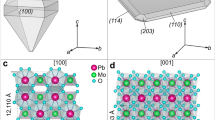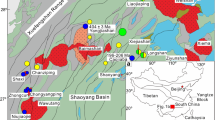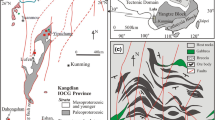Abstract
We report the first occurrence of Hf-rich kosnarite [K(Hf,Zr)2(PO4)3], space group R-3c, Z = 6, in the giant Chaquicocha high-sulfidation epithermal gold deposit in the Yanacocha mining district, Peru. Kosnarite crystals are small (<100 μm) and occur in 2–3-mm-thick veins that cut intensively silicified rocks. The paragenesis includes a first stage of As-free pyrite and quartz (plus gratonite and rutile), followed by trace metal-rich pyrite [(Fe,As,Pb,Au)S2] and secondary Fe sulfates. Kosnarite is associated with quartz and is clearly late within the paragenetic sequence. Electron microprobe analyses (EMPA) of kosnarite show relatively high concentrations of HfO2 and Rb2O (7.61 and 1.05 wt.%, respectively). The re-calculated chemical formulas of kosnarite vary from KΣ1.00(Zr1.93Na0.01Hf0.01Mn0.01)Σ1.96(P3.04O4)Σ3 to (K0.92Rb0.05Na0.03)Σ1.00(Zr1.81Hf0.19)Σ2.00 [(P2.98Si0.02As0.01)Σ3.01O4]Σ3, where Hf and Rb are most likely incorporated according to a coupled substitution of Hf4+ + Rb+ ⇔ Zr4+ + K+. Back-scattered electron (BSE) images and elemental mapping of kosnarite reveal that Hf and Rb are enriched in 2–10-μm-wide oscillatory and/or sector zones. High-angle annular dark-field scanning transmission electron microscopy (HAADF-STEM) observations of such zones reveal a pattern of alternating, 5–50-nm-thick, Hf-rich and Zr-rich nanozones. These high-resolution observations indicate that the incorporation of Hf does not appear to cause significant distortion in the kosnarite structure. Semiquantitative TEM-energy-dispersive X-ray spectrometry (EDS) analyses of the nano-layers show up to 22 wt.% of HfO2, which corresponds to 31 mol% of the hypothetical, KHf2(PO4)3, end-member. The presence of kosnarite in the advanced argillic alteration zone at Yanacocha is indicative of Hf and Zr mobility under highly acidic conditions and points towards an unforeseen role of phosphates as sinks of Zr and Hf in high-sulfidation epithermal environments. Finally, potentially new geochronological applications of highly insoluble vein kosnarite, including Rb-Sr dating, may provide further age constraints in pervasively altered areas where other isotopic systems might have been reset.



Similar content being viewed by others
References
Aja SU, Wood SA, Williams-Jones AE (1995) The aqueous geochemistry of Zr and the solubility of some Zr-bearing minerals. Appl Geochem 10:603–620
Bethke CM (1996) Geochemical reaction modelling: concepts and applications. Oxford University Press, New York
Birch WD, Pring A, Bevan K, Bevan DJM (1994) Wycheproofite: a new hydrated sodium aluminum zirconium phosphate from Wycheproof, Victoria, Australia, and a new occurrence of kosnarite. Mineral Mag 58:635–639
Birch WD, Pring A, Foord EE (1995) Selwynite, NaK(Be,Al)Zr2(PO4)4·2H2O, a new gainesite-like mineral from Wycheproof, Victoria, Australia. Can Mineral 33:55–59
Brown P, Curti E, Grambow B (2005) Chemical thermodynamics of zirconium. Chemical Thermodynamics 8. Elsevier Science Publishers B.V, Amsterdam, https://www.oecd-nea.org/dbtdb/pubs/vol8-zirconium.pdf. Accessed 13 Aug 2014
Brownfield ME, Ford EE, Sutley SJ, Botinelly T (1993) Kosnarite. KZr2(PO4)3, a new mineral from Mount Mica and Black Mountain, Oxford County, Maine. Am Mineral 78:653–656
Chouinard A, Williams-Jones AE, Leonardson AW, Hodgson CJ, Silva P, Tellez C, Vega J, Rojas F (2005) Geology and genesis of the multistage high-sulfidation epithermal Pascua Au-Ag-Cu deposit, Chile and Argentina. Econ Geol 100:463–493
Deditius AP, Utsunomiya S, Renock D, Ewing RC, Ramana CV, Becker U, Kesler SE (2008) A proposed new form of arsenian pyrite: composition, nanostructure and geochemical significance. Geochim Cosmochim Acta 72:2919–2933
Dill HG (2003) A comparative study of APS minerals of the Pacific Rim fold belts with special reference to South American argillaceous deposit. J S Am Earth Sci 16:301–320
Huminicki DMC, Hawthorne FC (2002) The crystal chemistry of the phosphate minerals. In: Kohn MJ, Rakovan J, Hughes JM (eds) Phosphates: geochemical, geobiological, and materials importance, 48. Rev Mineral Geochem, Mineralogical Society of America, Washington, DC, pp 123–253
Johnson JW, Oelkers EH, Helgeson HC (1992) SUPCRT92: a software package for calculating the standard molal thermodynamic properties of minerals, gases, aqueous species, and reactions from 1 to 5000 bar and 0 to 1000 °C. Comput Geosci 18:899–947
Linnen RL, Samson IM, Williams-Jones AE, Chakhmouradian AR (2014) Geochemistry of the rare-earth element, Nb, Ta, Hf, and Zr deposits. In: Holland H, Turekian K (eds) Treatise on geochemistry, second edition, vol 13:543–568
Longo AA (2000) The Carachugo-San Jose-Chaquicocha gold trend, Yanacocha district, northern Peru. In: Cluer JK, Price JG, Struhsacker EM, Hardyman RF, Morris CL (eds) Geology and ore deposits 2000, The Great Basin and Beyond, Geological Society of Nevada Symposium Proceedings, Reno/Sparks, Nevada, May 15–18, 2000, v. 1, p 201–220
Longo AA, Dilles JH, Grunder AL, Duncan R (2010) Evolution of calc-alkaline volcanism and associated hydrothermal gold deposits at Yanacocha, Peru. Econ Geol 105:1191–1241
Magdisov AA, Williams-Jones AE, van Hinsberg V, Salvi S (2011) An experimental study of the solubility of baddeleyite (ZrO2) in fluoride-bearing solutions at elevated temperature. Geochim Cosmochim Acta 75:7426–7434
More PB, Takaharu A, Steele IM, Swihart GH (1983) Gainesite, sodium zirconium beryllophosphate: a new mineral and its crystal structure. Am Mineral 68:1022–1028
Peterson EC, Mavrogenes JA (2014) Linking high-grade gold mineralization to earthquake-induced fault-valve processes in the Porgera gold deposit, Papua New Guinea. Geology 42:383–386
Putnis A, Fernandez-Diaz L, Prieto M (1992) Experimentally produced oscillatory zoning in the (Ba, Sr)SO4 solid solution. Nature 358:743–745
Rubin JN, Henry CD, Price JG (1993) The mobility of zirconium and other “immobile” elements during hydrothermal alteration. Chem Geol 110:29–47
Shore M, Fowler AD (1996) Oscillatory zoning in minerals: a common phenomenon. Can Mineral 34:1111–1126
Shtukenberg AG, Punin YO, Artamova OI (2009) Effect of crystal composition and growth rate on sector zoning in solid solutions grown from aqueous solutions. Mineral Mag 73:385–398
Simmons SF, White NC, John DA (2005) Geological characteristics of epithermal precious and base metal deposits. Econ Geol 100th Ann Vol. 1905–2005 100: 485–522
Stowell H, Zuluaga C, Boyle A, Bulman G (2011) Garnet sector and oscillatory zoning linked with changes in crystal morphology during rapid growth, North Cascades, Washington. Am Mineral 96:1354–1362
Teal L, Benavides A (2010) History and geologic overview of the Yanacocha mining district, Cajamarca, Peru. Econ Geol 105:1173--1190
Watson EB, Liang Y (1995) A simple model for sector zoning in slowly grown crystals: implications for growth rate and lattice diffusion, with emphasis on accessory minerals in crystal rocks. Am Mineral 80:1179–1187
Acknowledgments
The authors are grateful to Carl Henderson for the help with EMPA analyses conducted at the Electron Microbeam Analysis Laboratory (EMAL) at the University of Michigan. The comments by Atanas Hikov, Anthony Longo, Pietro Vignola, and Robert Linnen (Associate Editor) greatly improved the quality of the manuscript. Support for this study was provided by NSF EAR 052093 to Utsunomiya and Kesler. Financial support was provided by Japan Society of the Promotion of Science (JSPS) to Utsunomiya. Martin Reich acknowledges support from FONDAP project 246 15090013, FONDECYT grant 1130030, and MSI grant Millennium Nucleus for Metal Tracing Along Subduction (NC130065).
Author information
Authors and Affiliations
Corresponding author
Additional information
Editorial handling: R. Linnen
Rights and permissions
About this article
Cite this article
Deditius, A.P., Utsunomiya, S., Sanchez-Alfaro, P. et al. Constraints on Hf and Zr mobility in high-sulfidation epithermal systems: formation of kosnarite, KZr2(PO4)3, in the Chaquicocha gold deposit, Yanacocha district, Peru. Miner Deposita 50, 429–436 (2015). https://doi.org/10.1007/s00126-015-0586-z
Received:
Accepted:
Published:
Issue Date:
DOI: https://doi.org/10.1007/s00126-015-0586-z




